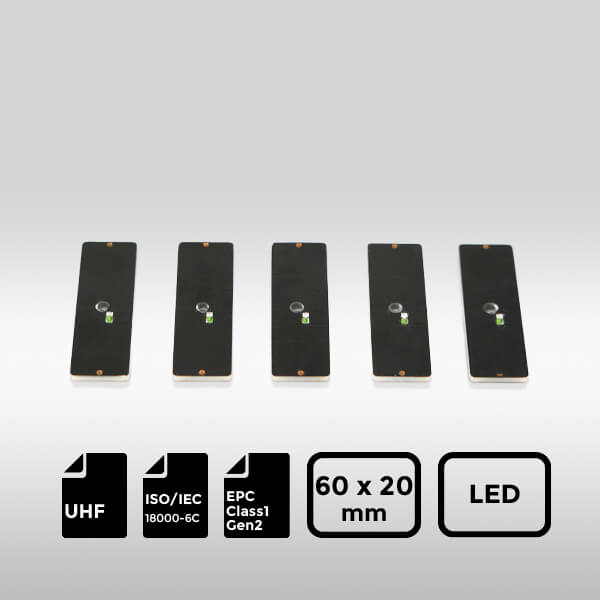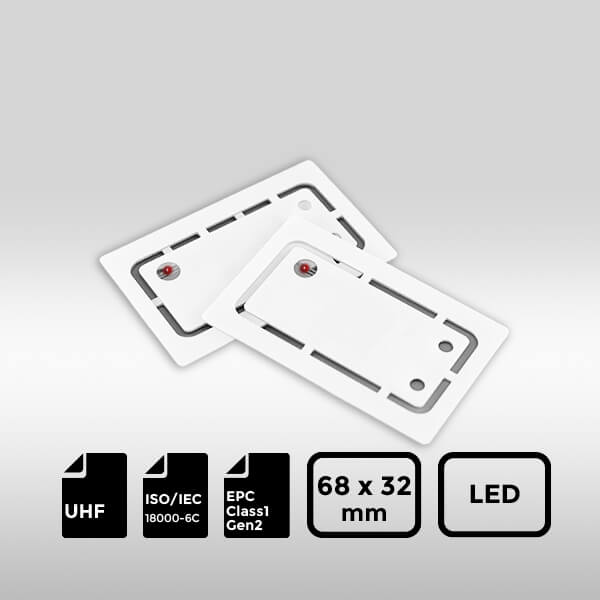
Basic Concepts of RFID Antennas
RFID antennas are devices engineered to transmit signals via radio waves and are indispensable to RFID systems. The antenna is responsible for receiving signals emitted by RFID tags and relaying them to the RFID reader/writer. Conversely, it also transmits signals from the reader/writer back to the tags.The operational principle of RFID antennas is predicated on the propagation of electromagnetic waves. Upon the emission of a signal by the RFID reader/writer, the antenna transmits this signal to the tags in the form of electromagnetic waves. Upon receiving the signal, the tags reflect data back to the antenna, which subsequently transmits the data to the reader/writer for processing.This wireless communication methodology not only expedites data exchange but also mitigates the limitations inherent in traditional contact-based devices.Key Components of RFID Antennas
RFID antennas comprise several essential components, the design and selection of which directly impact the antenna’s performance characteristics.Antenna Material: The constituent material of the antenna is a significant determinant of its performance. Common materials include copper, aluminum, and conductive plastics. Copper is frequently employed in the fabrication of efficient RFID antennas due to its low resistance and exceptional conductivity. Aluminum, conversely, is often utilized in cost-sensitive applications due to its lower cost and suitability for mass production. Conductive plastics find application in certain flexible antennas, which are well-suited for wearable devices and similar applications.Antenna Shape and Size: The shape and size of the antenna directly influence its signal transmission efficiency and coverage area. Common shapes include linear antennas, loop antennas, and planar antennas. Linear antennas are generally more effective for longer reading distances, whereas planar antennas are optimal for use in confined spaces.Antenna Frequency: RFID systems typically operate across various frequency ranges, including low frequency (LF), high frequency (HF), and ultra-high frequency (UHF). The design of antennas for different frequencies affects the distance and penetration of signal transmission. UHF antennas are well-suited for applications requiring long-range reading, while HF antennas are ideal for short-range, high-precision systems.Electromagnetic Wave Radiation Pattern: The radiation pattern of RFID antennas dictates the range and direction of their signal coverage. Omnidirectional antennas emit and receive signals uniformly in all directions (360 degrees), rendering them suitable for broad area applications. Directional antennas, conversely, focus signals in a specific direction, which is advantageous in scenarios requiring precise positioning.The Role of RFID Antennas in RFID Systems
RFID antennas perform functions beyond signal transmission in RFID systems; they also influence system performance and stability. The primary functions of these antennas are detailed below:Signal Transmission and Reception: The antenna is a critical component for signal exchange between tags and the reader. It enables the RFID reader to emit electromagnetic waves and receive signals returned by the tags. The design and quality of the antenna directly affect the efficiency and accuracy of signal transmission.Increasing Reading Distance: The reading distance of RFID systems is influenced by the antenna design. High-quality antennas can enhance signal strength and coverage, resulting in longer reading distances and enabling RFID systems to effectively identify tags from greater distances.Interference Resistance: In complex environments, RFID systems may encounter electromagnetic interference. High-performance RFID antennas can effectively mitigate external disruptions, ensuring signal stability and data accuracy. This is particularly important for RFID applications in complex environments such as warehousing and logistics.Optimizing Multi-Tag Reading: In scenarios requiring the simultaneous identification of multiple tags, a well-designed RFID antenna enhances multi-tag reading efficiency, minimizes signal conflicts, and ensures accurate tag recognition.Types and Applications of RFID Antennas
RFID antennas are available in various types, each tailored to specific application requirements and possessing unique advantages and ideal use cases:Near-Field Antennas and Far-Field Antennas: Near-field antennas primarily facilitate short-distance communication, typically identifying tags within a limited range. Far-field antennas, conversely, can cover larger areas, making them suitable for long-range identification and large-scale applications.Flat Antennas: Flat antennas are favored for their simple design and high durability, often employed in embedded systems, compact devices, and space-constrained environments.Circular Antennas: Circular antennas excel in high-frequency RFID applications due to their excellent omnidirectional radiation characteristics, making them suitable for environments requiring efficient coverage.Directional Antennas and Omnidirectional Antennas: Omnidirectional antennas provide 360-degree signal coverage, making them ideal for large-area system applications. Directional antennas, conversely, provide focused signals, which are advantageous for precise positioning and long-distance reading scenarios.Selection and Optimization of RFID Antennas
Selecting the appropriate RFID antenna involves consideration of factors beyond performance, including cost, space constraints, and application requirements. Key considerations for antenna selection and optimization are outlined below:Select the right type of antenna: Choose the antenna type based on your application needs. For instance, if you need wide coverage, opt for an omnidirectional antenna; if long-range identification is necessary, go with a far-field antenna.Optimizing antenna performance: Enhancing antenna performance involves not only increasing signal strength but also optimizing the layout, material selection, and frequency selection. Proper optimization can enhance system efficiency and minimize signal interference.Future technology trends: As RFID technology continues to advance, future RFID antennas may integrate with smart technologies and sensor technologies, providing more multifunctional solutions such as smart antennas and integrated antennas. These innovations will further drive the development of RFID applications.Conclusion
RFID antennas are essential components of RFID systems. They are responsible for transmitting and receiving signals and directly influence key performance factors such as reading distance, interference resistance, and multi-tag reading capability. As RFID technology continues to evolve, advancements are being made in both antenna design and application.The appropriate selection and optimization of RFID antennas can significantly enhance the overall performance of RFID systems. As RFID technology gains wider adoption, RFID antennas will play an increasingly crucial role across various fields, driving innovation and enhancing technological applications. Continuous optimization of RFID antenna design will facilitate the creation of more efficient and accurate wireless identification systems, thereby enabling industries to enhance management efficiency and achieve greater levels of smart integration.FAQs
How do the installation location and orientation of RFID antennas impact system performance?
The position and orientation of RFID antennas directly affect the reading range and efficiency of the system. Install antennas in locations that maximize signal coverage, ensuring their radiation pattern aligns with the target area’s needs. Use an omnidirectional antenna placed high up for even signal distribution in large areas. For smaller areas requiring higher precision, opt for a directional antenna. Adjust the antenna’s angle and orientation based on the environment to achieve optimal performance.How do RFID antennas deal with electromagnetic interference in different environments?
In complex electromagnetic environments, RFID antennas might encounter interference from other electronic devices. To alleviate this impact, designers often equip RFID antennas with anti-interference technologies, using high-quality shielding materials to prevent signal leakage and block external interference. Additionally, opting for high-gain antennas, utilizing frequency-hopping techniques, and tweaking the antenna’s reception mode (whether directional or omnidirectional) can also help effectively reduce interference and enhance system stability and accuracy.How can compatibility issues between RFID antennas and tags be resolved?
Compatibility issues between RFID antennas and tags usually relate to frequency range, signal strength, and the operational modes of the tags. Antennas must match the frequency bands of the tags they support; generally, low-frequency antennas pair with low-frequency tags, while high-frequency antennas pair with high-frequency tags. To ensure good compatibility, choose the right antenna type based on the environment. For instance, ultra-high frequency antennas are more suitable for long-range applications, while high-frequency antennas are better for short-range, precision identification. Making sure that the frequencies of the tags and antennas match is key to achieving efficient system performance.Recommended products

UHF On-Metal LED Tag 60×20×3mm | ISO18000-6C
The on metal LED UHF tag, renowned for its anti-metal properties and resistance to extreme temperatures, liquids, and damage, is widely used in manufacturing logistics for containers, shelves, equipment, and more. It also offer security, authentication, and traceability solutions for transportation logistics.

UHF LED RFID Hang Tag 86×54×1mm | ISO18000-6C
LED RFID Hang Tags are used in commercial activities such as machinery and equipment management or clothing management. The tags are based on traditional RFID/NFC tags with red LED lights reminders and can be used in warehouse management, laundry room scenarios, etc.

RFID Antenna UHF
15-Meter Cable for UHF RFID Fixed Reader
UHF Tag
4″x2″ 860-960MHz UHF RFID Label RFID M4D
UHF Tag
4″x4″UHF RFID Label Alien H3 | ISO18000-6C
RFID Antenna UHF
5-Meter Cable for UHF RFID Fixed Reader
HF Card
ABS RFID KEY-FOB Tag RFID Classic 1K
HF Card
ABS RFID KEY-FOB Tag RFID Classic 4K
HF Card
ABS RFID KEY-FOB Tag RFID Ultralight C
HF Tag
ABS RFID KEY-FOB Tag RFID Ultralight EV1
LF Card
ABS RFID KEY-FOB Tag ATA5577
LF Card
ABS RFID KEY-FOB Tag EM4200
HF Card
ABS RFID KEY-FOB Tag EM4305
HF Card
ABS RFID KEY-FOB Tag RFID TAG 213